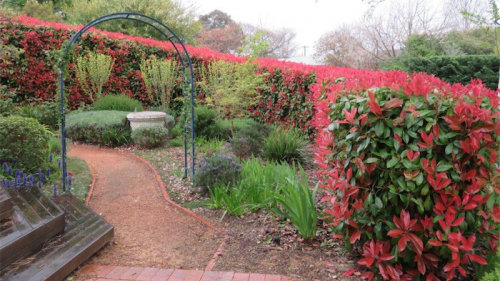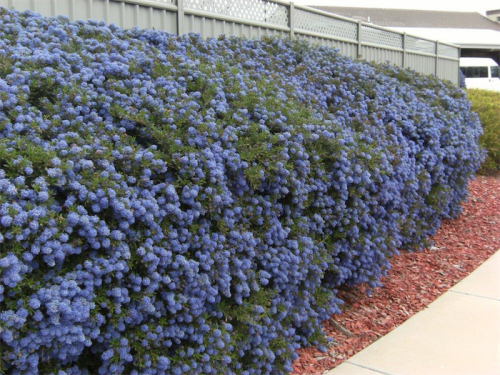

Pruning is also a way of promoting spring leaf colour. For example, Photinia robusta hedges present a stunning display at present and have always been popular due to their fast growth. Pictured here is a Photinia hedge in our front garden that was trimmed about eight weeks ago.
We keep it low in the front so as not to present a security risk by screening the front door and rising higher between our neighbours.
However, unless pruned regularly, most shrubs – whether grown as individual specimens or as a hedge – can quickly grow out of control.
VOTED by the nursery industry as Shrub of the Year in 1979, Ceanothus “Blue Pacific” has to be one of the most overrated shrubs ever grown.
Admittedly, its blue flowers at this time look fantastic, as seen here in Queanbeyan. But with tens of thousands sold and possibly an equal number of disappointed gardeners discovering that training has to start from almost the day it’s planted, with a very light trim after flowering every year.
Like conifers, it simply won’t grow from the old wood. I have had dozens of inquiries seeking advice on what can be done about all the bare wood and no new growth. The simple answer is, nothing.
To my knowledge, it’s the only member of a possible 100 varieties of the Ceanothus family, all from California, that has this problem. The plants range from groundcovers to more than 12 metres and the whole family is perfect for Australian conditions and yet rarely grown by wholesale nurseries. Ceanothus is well suited to growing in conjunction with native plants.

Nowadays, common sense has prevailed and we don’t consider native plants as any different to other shrubs. The rule of thumb for most plants is to prune after flowering by reducing the height and sides by a maximum of up to but not more than one third at any one time.
I HAVE had many comments in regard to the flowering of bulbs this year. In almost all instances there is abundant leaf growth and few flowers.
Certainly, this has been the case in our garden and with some groups of daffodils it’s been all leaves and no flowers. Also, when they do flower because of the long stalks, the flowers simply flop over, nearly touching the ground.
A bulb grower suggested that it was the copious amounts of rain and a mild winter that promoted lush foliage at the expense of flowers.
Interestingly, the non-appearance of flowers has been evident in other shrubs, such as magnolias. Both our Magnolia stellata or Star Magnolia and a huge Magnolia soulangeana next door always present a superb display, but this year the floral display has been pathetic.
Jottings…
- Don’t prune now-in-flower Banksia rose until after flowering.
- Watch out for aphids on roses and new leaves on maples. Use Pyrethrum to keep them under control.
- Feed roses with certified organic Neutrog Seamungus.
- Continue to plant dahlia tubers.
Who can be trusted?
In a world of spin and confusion, there’s never been a more important time to support independent journalism in Canberra.
If you trust our work online and want to enforce the power of independent voices, I invite you to make a small contribution.
Every dollar of support is invested back into our journalism to help keep citynews.com.au strong and free.
Thank you,
Ian Meikle, editor




Leave a Reply